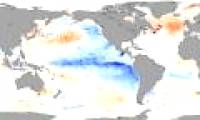
Meteorologists predict that the La Nina phenomenon could appear early next year with a weak impact and only last for a short time.

El Nino, La Nina and ENSO are all dangerous extreme weather phenomena.

New modeling research shows that El Niño and La Niña that have existed for the past 250 million years have influenced Earth's climate.

Rising ocean and land temperatures provide extra heat and moisture, helping storms intensify and bring heavy rain around the world.

Scientists at the US National Oceanic and Atmospheric Administration (NOAA) have issued their highest forecast yet for the Atlantic hurricane season: 17 to 25 named storms.

Will the appearance of La Nina make the 2024 storm season in the East Sea more fierce?

The US National Weather Service predicts El Nino will weaken in the next few months, giving way to the La Nina phenomenon that could cool global temperatures.

Winter this year will be colder than in 2016, the North is also about to enter the coldest period of winter.

La Nina is a phenomenon of cold sea water compared to normal, this is a phenomenon contrary to the phenomenon of El Nino (sea water warming).

According to the Central Hydrometeorological Forecast Center, from now to the end of 2016, there will be 6-8 storms and tropical depressions operating in the South China Sea, of
 Meteorologists predict that the La Nina phenomenon could appear early next year with a weak impact and only last for a short time.
Meteorologists predict that the La Nina phenomenon could appear early next year with a weak impact and only last for a short time. El Nino, La Nina and ENSO are all dangerous extreme weather phenomena.
El Nino, La Nina and ENSO are all dangerous extreme weather phenomena. New modeling research shows that El Niño and La Niña that have existed for the past 250 million years have influenced Earth's climate.
New modeling research shows that El Niño and La Niña that have existed for the past 250 million years have influenced Earth's climate. Rising ocean and land temperatures provide extra heat and moisture, helping storms intensify and bring heavy rain around the world.
Rising ocean and land temperatures provide extra heat and moisture, helping storms intensify and bring heavy rain around the world. Scientists at the US National Oceanic and Atmospheric Administration (NOAA) have issued their highest forecast yet for the Atlantic hurricane season: 17 to 25 named storms.
Scientists at the US National Oceanic and Atmospheric Administration (NOAA) have issued their highest forecast yet for the Atlantic hurricane season: 17 to 25 named storms. Will the appearance of La Nina make the 2024 storm season in the East Sea more fierce?
Will the appearance of La Nina make the 2024 storm season in the East Sea more fierce? The US National Weather Service predicts El Nino will weaken in the next few months, giving way to the La Nina phenomenon that could cool global temperatures.
The US National Weather Service predicts El Nino will weaken in the next few months, giving way to the La Nina phenomenon that could cool global temperatures. Winter this year will be colder than in 2016, the North is also about to enter the coldest period of winter.
Winter this year will be colder than in 2016, the North is also about to enter the coldest period of winter. La Nina is a phenomenon of cold sea water compared to normal, this is a phenomenon contrary to the phenomenon of El Nino (sea water warming).
La Nina is a phenomenon of cold sea water compared to normal, this is a phenomenon contrary to the phenomenon of El Nino (sea water warming). According to the Central Hydrometeorological Forecast Center, from now to the end of 2016, there will be 6-8 storms and tropical depressions operating in the South China Sea, of
According to the Central Hydrometeorological Forecast Center, from now to the end of 2016, there will be 6-8 storms and tropical depressions operating in the South China Sea, of









 Why did the ancient Babylonian civilization perish? Was it because they considered 'that thing' a daily meal?
Why did the ancient Babylonian civilization perish? Was it because they considered 'that thing' a daily meal? Just discovered a 72km 'tear in the Earth', the world's second largest country is in fear of a tsunami attack
Just discovered a 72km 'tear in the Earth', the world's second largest country is in fear of a tsunami attack Top 7 facts about the hottest place in the world, where you can fry eggs at outdoor temperature
Top 7 facts about the hottest place in the world, where you can fry eggs at outdoor temperature The Qing Dynasty collapsed, what surname did 20,000 royal descendants change to to integrate into the new era?
The Qing Dynasty collapsed, what surname did 20,000 royal descendants change to to integrate into the new era? After 389 days in the Arctic, costing more than $160 million, hundreds of scientists brought back bad news: What was it?
After 389 days in the Arctic, costing more than $160 million, hundreds of scientists brought back bad news: What was it? How long does it take to fall in love with someone?
How long does it take to fall in love with someone? How much silver has ever been discovered in the world?
How much silver has ever been discovered in the world? How does an atomic bomb work?
How does an atomic bomb work?